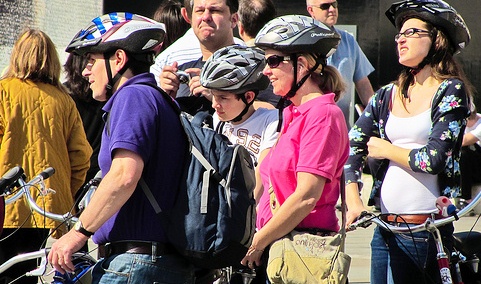
A Nantwich headteacher has clinched a deal to provide cheaper cycle helmets in a bid to save pupils’ lives.
Andrew Cliffe, of Brine Leas School, acted after two accidents involving students in the space of a week.
Now he has managed to secure a deal with a local supplier so parents can buy helmets for £10.99 – half the normal £20.99.
And he has warned parents that any pupils found biking to school without helmets will have to find another way to travel in.
Mr Cliffe said: “There were two accidents involving cyclists in a week. One of the students was wearing a helmet and it is likely this saved him from even more serious injury.
“Although I do not wish to discourage students cycling to school, if they cycle to school without a helmet then they will have to find another way of getting here.
“I cannot have a serious injury or fatality on my conscience when I can actually make journeys safer with a little bit of effort.”
Research has shown that correctly worn helmets can be 80% effective in preventing damage/injury to the head on impact.
A spokesman for RoSPA (Royal Society for Prevention of Accidents), said: “Cycling accidents increase as children grow older, with 10 to 15 year old riders being more at risk than other age groups.
“We recommend all cyclists wear a cycle helmet that meets a recognised safety standard. Cycle helmets, when correctly worn, are effective in reducing the risk of receiving major head or brain injuries in an accident.”
“The next step is simple,” added Mr Cliffe.
“Wear your helmet to cycle to school, buy your own helmet or take advantage of the deal the school has brokered.”
Mr Cliffe is also considering introducing American-style lockers for students to encourage them.

















Mr Cliffe is sadly mistaken to think that enforcing helmet wearing will make his cycling pupils safer. If anything it will make those who continue to cycle less safe, and his special offer on cycle helmet purchase from a nominated source, is a seriously questionable move which could be challenged as a commercial association, although the article tactfully does not name the local supplier, being forced against freedom of choice. Put simply just putting on a lid won’t stop crashes happening, and helmet advocates are in many ways abdicating from dealing with the real issues that are behind the recent increase in reported crashes, for pupils on their way to school.
Perhaps we need to learn a little more about the 2 crashes, which have prompted his decision, and how he might address what he rightly recognises as a Duty of Care issue, along the lines of good practice in the related delivery of Health & Safety interventions, which with the school, just as with an employer, means applying measures in line with a clear hierarchy.
The first measure to consider is removing the hazard. At present that hazard is not revealed – were these pupils hit by motor vehicles when riding on the carriageway? or more probably did they crash when riding on a footway,or off carriageway route – crashes on footways etc exceed those on carriageways by typically a factor of 8. Remove the hazard as the first act, or mitigate it and as with every other health & safety policy, only as a last resort do you demonstrate the failure of all other interventions and demand that the ‘victim’ has to be shielded with the armourplating of protective equipment, because the hazard is not being properly managed
I am reminded of a young widow whose 7 year old by necessity walked to school on his own. he crossed minor roads on his own and used 2 crossing patrols en route. He was knocked down and suffered a broken arm, with an immediate outcry that he should have been driven to school, until his mother made the strong point that her child had been hit outside the school by one of the other parents adding to the chaos of car movements at the school gate, and she was certainly not going to make matters even less safe by driving to school with her child.
So let us see the analysis of these crashes, perhaps the children need to get better trained, or even ride in organised groups, it may even be the hiatus of motor vehicle movements at school closing time that is the detail to deal with. One thing is certain though wearing a cycle helmet won’t sort out the fundamantal problem.
A few points:
1) Head teachers have no power to ban pupils from cycling to school, with or without helmets. A head teacher’s health and safety responsibilities end at the school gate – what the pupils do on the public highway is up to them.
2) Where head teachers try to impose helmet rules, cycle use nose-dives. Result: more traffic congestion, pollution and parking problems on the surrounding roads, pupils who are less alert and less healthy, and ultimately, less chance of them cycling later in life.
3) That in turn will shorten far more lives through increased obesity, diabetes, heart disease etc. The health benefits of cycling far outweigh the risks involved: by c20:1 according to one estimate. The other side of this coin is that the risks of cycling are (mercifully) not especially high – you are less likely to be killed in a mile of cycling than a mile of walking. Do Mr Cliffe’s pupils need walking helmets too?
4) From the 20:1 ratio above, it can be shown that it takes only a 2% reduction in cycle use for helmet rules to shorten more lives than they could possibly save, even if they were 100% effective.
5) Cycle helmets aren’t anything like 100% effective. Indeed some evidence suggests they may even be counter-productive to the safety of those who wear them (as well as undermining the health of those who decide simply to give up cycling). They are (and can only be) designed to withstand minor knocks and falls, not serious traffic collisions. Some evidence suggests they may increase the risk of cyclists having falls or collisions in the first place, or suffering neck injuries. Whilst helmet laws in countries like Australia and New Zealand have reduced cyclists’ injury numbers, the evidence suggests this is wholly or mainly due to reductions in cycle use, not improvements in safety for the cyclists who remain. Reduced cycle use may itself explain why the remaining cyclists are more at risk, due to the loss of the benefits they previously gained from ‘safety in numbers’.
Full references to all of the above claims here:
http://www.ctc.org.uk/resources/Campaigns/Cycle-helmets-(the-evidence)_brf.pdf
Faced with mounting climate and obesity crises, the last thing we need is to force children into increasingly car-dependent, sedentary lifestyles.
Roger Geffen
Campaigns & Policy Director
CTC, the national cyclists’ organisation
The biggest danger facing kids today is not death by cycling. It is death in a traffic accident whislt a car pasenger, and the long term effects of lack of an active lifestyle.
Cycling to school, whether or not you wear a helmet, is better than being driven for your long term health.
The headmaster would do far better to ensure each of his pupils is properly trained (to bikeability standards) than to impose counterproductive dress codes.
Will Mr Cliffe be insisting that those who walk or who are driven to school also wear helmets?
Is he aware that according to DfT figures there are more head and face injuries to pedestrians or car occupants than there are to cyclists?
If not – what are his real motives?
Perhaps he could tell us?
http://www.ctc.org.uk/DesktopDefault.aspx?TabID=5260
But the headmaster, Andrew Cliffe, is mistaken if he thinks that cycle helmets make cycling safer, as nowhere with a helmet law or massive rise in wearing after propaganda campaigns can show any reduction in risk to cyclists.
Cycle helmet laws and promotion have two effects: they deter some people from cycling and they make obscene profits for the helmet manufacturers, there is no safety benefit. The risks of cycling are about the same as those of walking, so will Mr Cliffe be insisting that his pedestrian pupils wear helmets too?
The health benefits of cycling are huge, with regular cyclists living longer and suffering less from all forms of illness, so it is more dangerous not to ride a bike than to ride one. Because the people deterred from cycling lose those health benefits, and will get sicker quicker and die earlier, the overall effect of helmet laws and propaganda is very large and negative. It may not be coincidence that the places which have had helmet laws for twenty years are the fattest people on earth.
In the middle of an obesity epidemic largely caused by reduced exercise levels, which will shorten millions of lives and cost billions of pounds, the promotion of cycle helmets is literally insane.
The research showing that “….that correctly worn helmets can be 80% effective in preventing damage/injury to the head on impact.” has been completely disproved and is no longer even supported by the original researchers.
Can I suggest that the Mr Cliffe might like to review his decision in the light of the facts, which he can find at cyclehelmets.org